Scottish Association of Young Farmers Clubs - board ready training: survey report
This report presents the findings of a survey carried out for the Scottish Associations of Young Farmers Clubs.
2. Survey Results
Summary
- This chapter reports the main findings of the survey.
- Most respondents were current board members (72%).
- The majority of current board members joined the Scottish Association of Young Farmers Clubs (SAYFC) board for personal development (92%).
- 41% of all respondents felt ‘slightly confident’ when joining the board, and mentoring, induction and support from the SAYFC helped board members feel confident.
- Training provided to the SAYFC board has been positively received by all respondents, with the majority (75%) stating that it had a positive impact.
- Current board members felt that balancing the voluntary role with other commitments was the most challenging part of being on the SAYFC board (54%) and previous board members found time commitment and managing workload the most challenging (75%).
- Half (50%) of all respondents felt that being a member of the SAYFC board did not meet their expectations. Reasons for this included over reliance on volunteer board members and feeling that the yearly turnover of board members makes it hard to bring about change.
This section of the report presents the main findings from each question of the survey[6]. Findings have been presented under the following sub-headings:
2.1 Respondent profile
2.2 Motivations for becoming a SAYFC board member
2.3 Preparing for the SAYFC board
2.4 SAYFC board training
2.5 Challenges and expectations
2.6 Further training and development
2.1 Respondent Profile
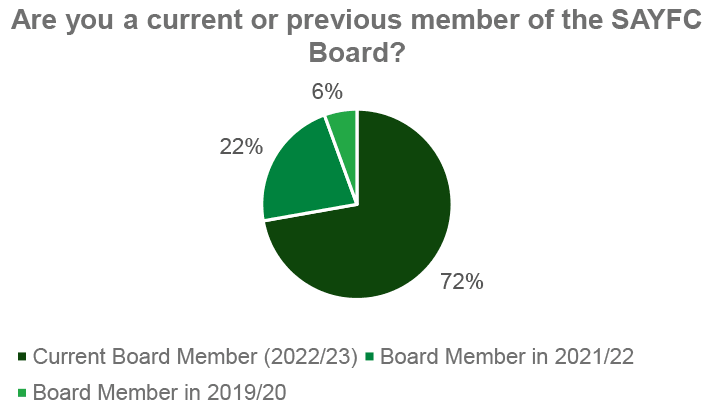
The majority of survey respondents were current members of the SAYFC board (72%). Just under a third (28%) were previous members. There were no respondents from 2020/2021. There are a range of roles on the SAYFC board (see section 1.2). Current and previous SAYFC board members who responded to the survey have held or currently hold a range of roles and the results are therefore broadly representative (10 out of 12 roles are represented in responses).
2.2 Motivations for Becoming a SAYFC Board Member
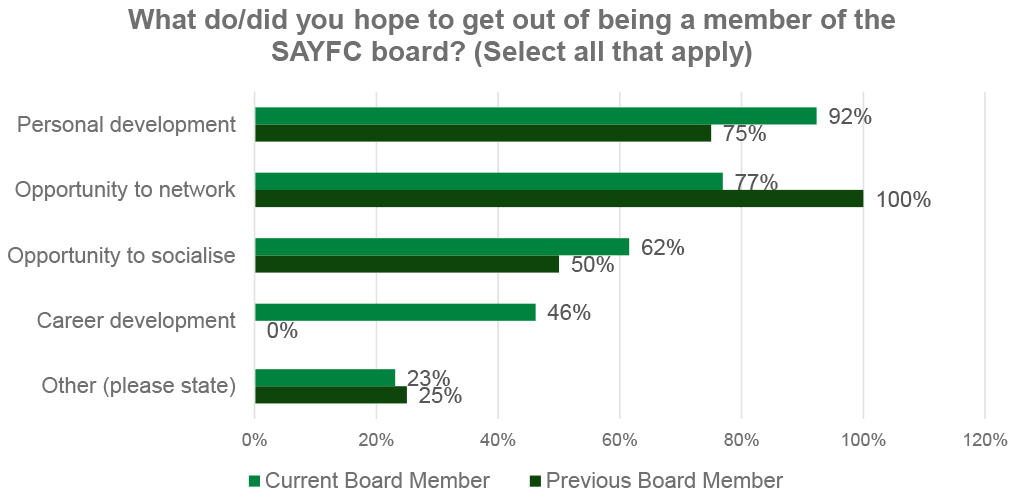
The majority of current SAYFC board members became members for their own personal development (92%). Just under half saw it as an opportunity for career development (46%). All previous SAYFC board members (100%) saw the experience as an opportunity to network, and half (50%) saw it as an opportunity to socialise. There were differences in motivations between the two groups. For example, whilst just under half (46%) of previous board members were motivated by career development, no current board members selected this.
Around a quarter (23% of current board members and 25% of previous board members) selected ‘Other’. The reasons they provided for joining the SAYFC board included:
- To give back to the organisation
- To make a difference
- To improve the organisation
2.3 Preparing for the SAYFC Board
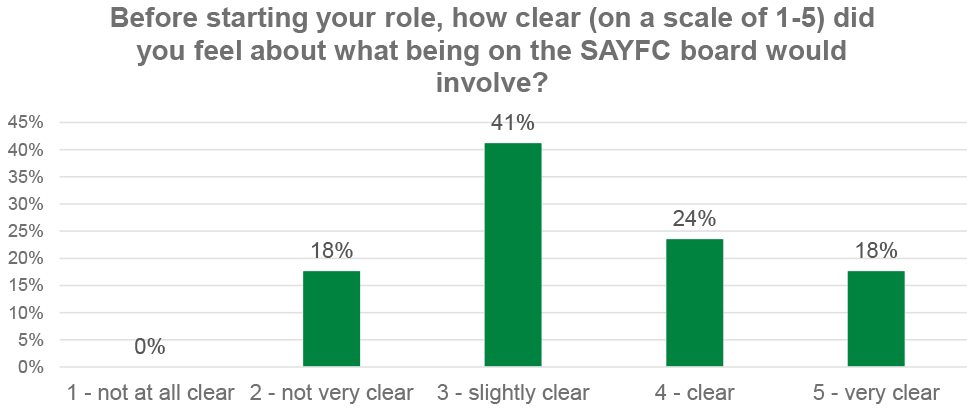
Current and previous members were most likely to say they felt ‘slightly clear’ on what being on the SAYFC board would involve (41%). Just under a quarter (24%) felt ‘clear’ and just under a fifth (18%) felt ‘very clear’.
Whilst just under a fifth answered ‘not very clear’ (18%), no respondents felt ‘not at all clear’.
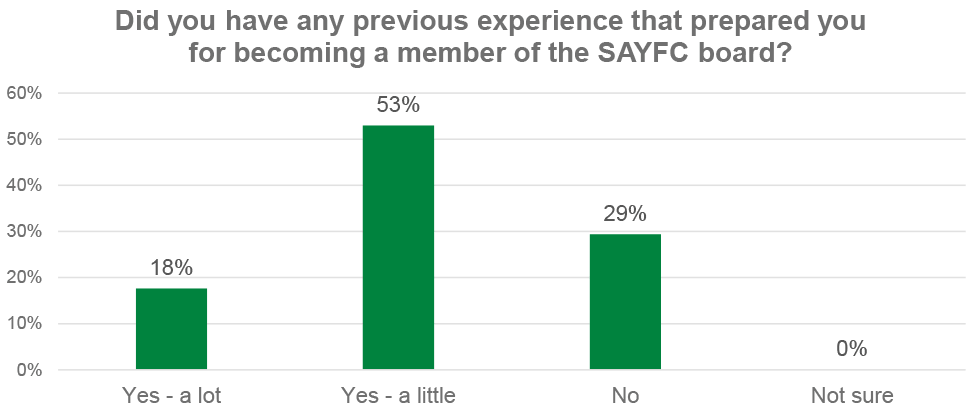
Over half (53%) of current and previous SAYFC board members felt they had ‘a little’ experience that prepared them for becoming a member of the SAYFC board. Just under a third of respondents (29%) felt they had no experience to prepare them. Almost a fifth (18%) said ‘yes – a lot’. No respondents said, ‘Not sure’.
Respondents were asked to explain their responses to this question. Below are examples of the type of experience respondents had:
- Sitting on other boards
- Holding other positions within the SAYFC
- Experience from their own career
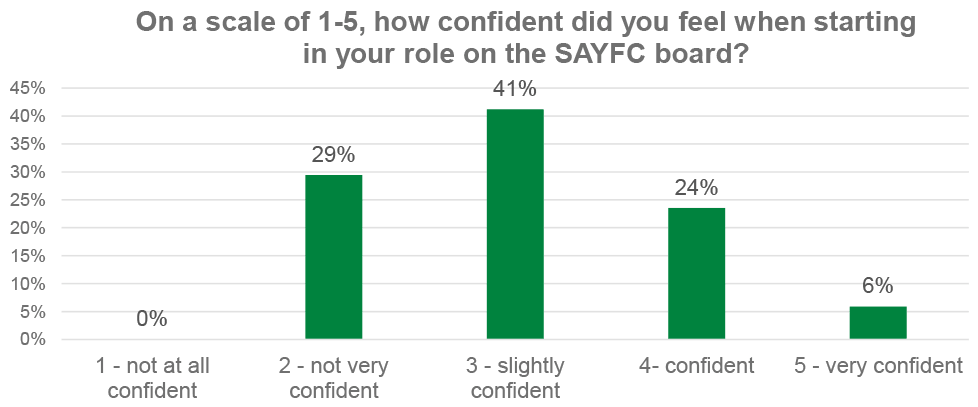
Current and previous SAYFC board members were most likely to feel ‘slightly confident’ when starting their role on the SAYFC board (41%). Just under a third (29%) felt ‘not very confident’ and almost a quarter (24%) felt confident. Only 6% of respondents felt very confident. No respondents felt ‘not at all confident’.
Respondents were asked to explain their responses to this question. Below are reasons for their responses.
Why respondents did feel confident:
- Having a mentor
- Previous experience provided confidence
- Being a naturally confident person
- Being prepared by previous SAYFC board members
- The SAYFC provide a supportive network
- Induction sessions were helpful
Why respondents did not feel confident:
- Being new to the role can be daunting
- Allowing a wider network to attend SAYFC board meetings would provide insight into what being on the SAYFC board is like
- Pre-board training could be tailored more to prepare for the expectations of a board member and relevant activities (for example, report writing)
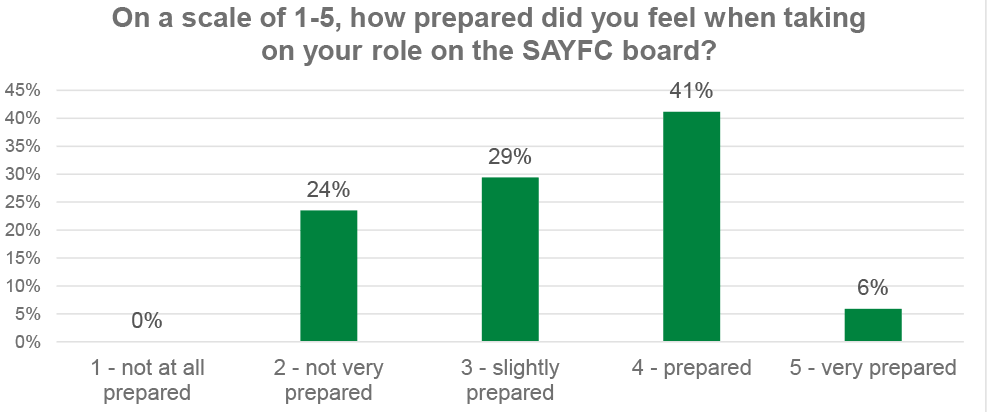
Nearly half (41%) of all current and previous SAYFC members felt ‘prepared’ when taking on their role on the SAYFC board. Just under a third of respondents (29%) felt ‘slightly prepared’ and almost a quarter (24%) felt ‘not very prepared’. Only 6% felt very prepared. No respondents felt ‘not at all prepared’.
Respondents were asked to explain their responses for this question. Below are reasons for their responses.
Why respondents felt prepared:
- Having held previous positions on the SAYFC board and knowing how the organisation works
- Previous work experience helped
Why respondents did not feel prepared:
- Staffing and resourcing may mean aims might not be achieved
- Induction was helpful, however more in-depth training would help
- Pushing themselves out of their comfort zone
- Training was not what was expected – key training was not provided (for example, accounts training, finances, difficult conversations, leadership training)
2.4 SAYFC Board Training
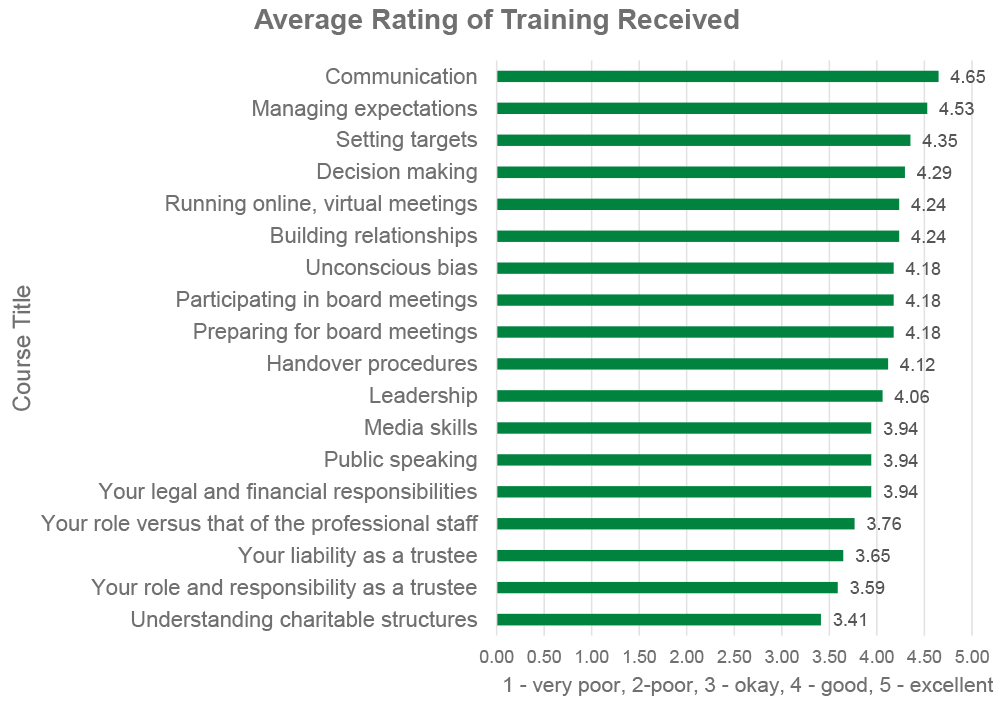
Respondents were asked to rate the training they have received throughout their time on the SAYFC board. These courses have covered a range of topics, from media skills and public speaking, to the roles and responsibilities of a trustee.
Respondents were asked to rate this training on a scale of 1-5, with 1 being ‘Very Poor’, 2 ‘Poor’, 3 ‘Okay’, 4 ‘Good’ and 5 ‘Excellent’. Respondents were also given the options of ‘did not receive this training’ and ‘can’t remember’.
Overall, current and previous SAYFC members rated the training they have received whilst on the SAYFC board relatively highly. Figure 7 presents the average scores. Respondents rated training on ‘communication’ the highest (4.65) and training on ‘understanding charitable structures’ the lowest (3.41).
Training with the highest average score:
1. Communication – 4.65
2. Managing expectations – 4.53
3. Setting targets – 4.35
Training with the lowest average score:
1. Understanding charitable structures – 3.41
2. Your role and responsibility as a trustee – 3.59
3. Your liability as a trustee – 3.65
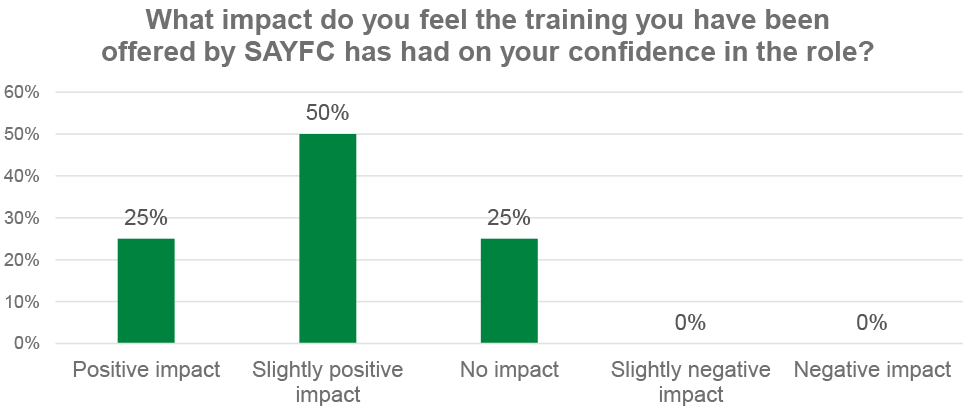
Half (50%) of current and previous SAYFC members felt that the training offered by SAYFC had a ‘slightly positive impact’. A quarter (25%) felt it had a ‘positive impact’ and a quarter felt it had no impact (25%). No respondents felt that the training had a negative impact.
Respondents were asked to explain their responses to this question. Below are some explanations for the impact of the training:
- Training outwith the SAYFC had a positive impact
- Mentoring has been positive and helped with development
- Minimal board training before joining the board officially
- Training helped boost confidence
- Training has had benefits outside of the SAYFC board role also
- Training should be targeted to those less confident (for example, leadership training)
- Learning on the job is sometimes the best
- No training received by SAYFC
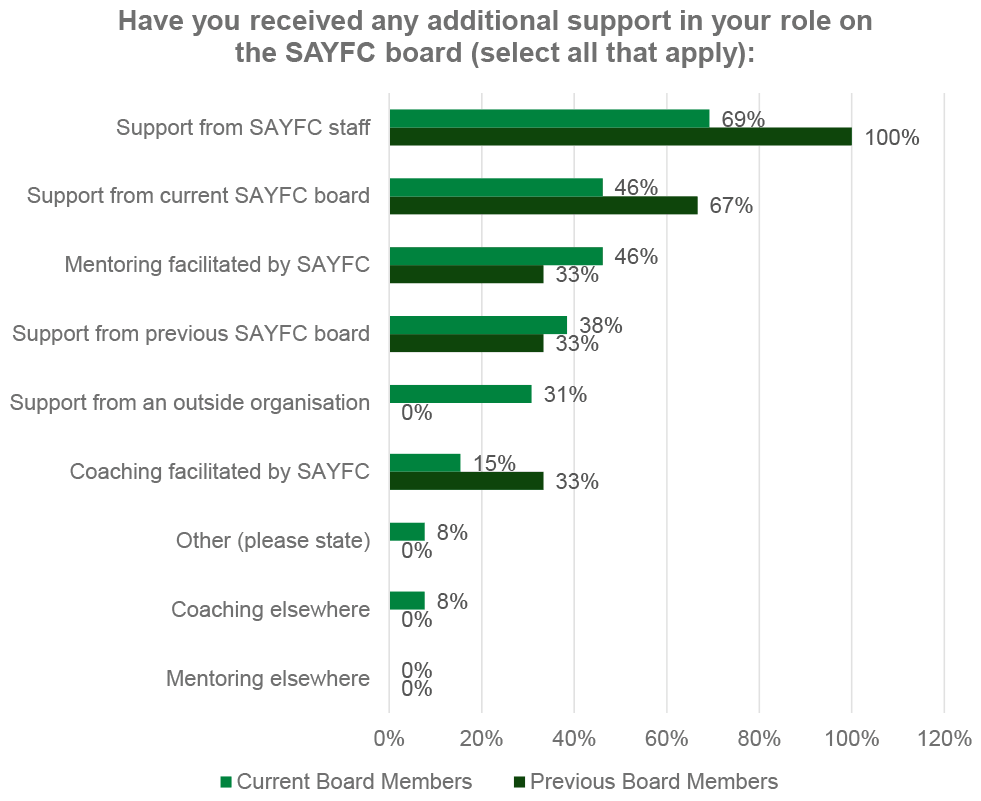
All previous SAYFC board members (100%) reported receiving support from SAYFC staff and, so far, the majority of current members reported the same (69%). Almost half (46%) of current members received additional support from mentoring facilitated by the SAYFC, which has had a positive impact, as mentioned above.
No current or previous SAYFC board members reported receiving mentoring elsewhere. No previous SAYFC board members reported receiving coaching elsewhere or support from an outside organisation. Current members mentioned receiving support from the Chairs of other organisations for young farmers.
2.5 Challenges and Expectations
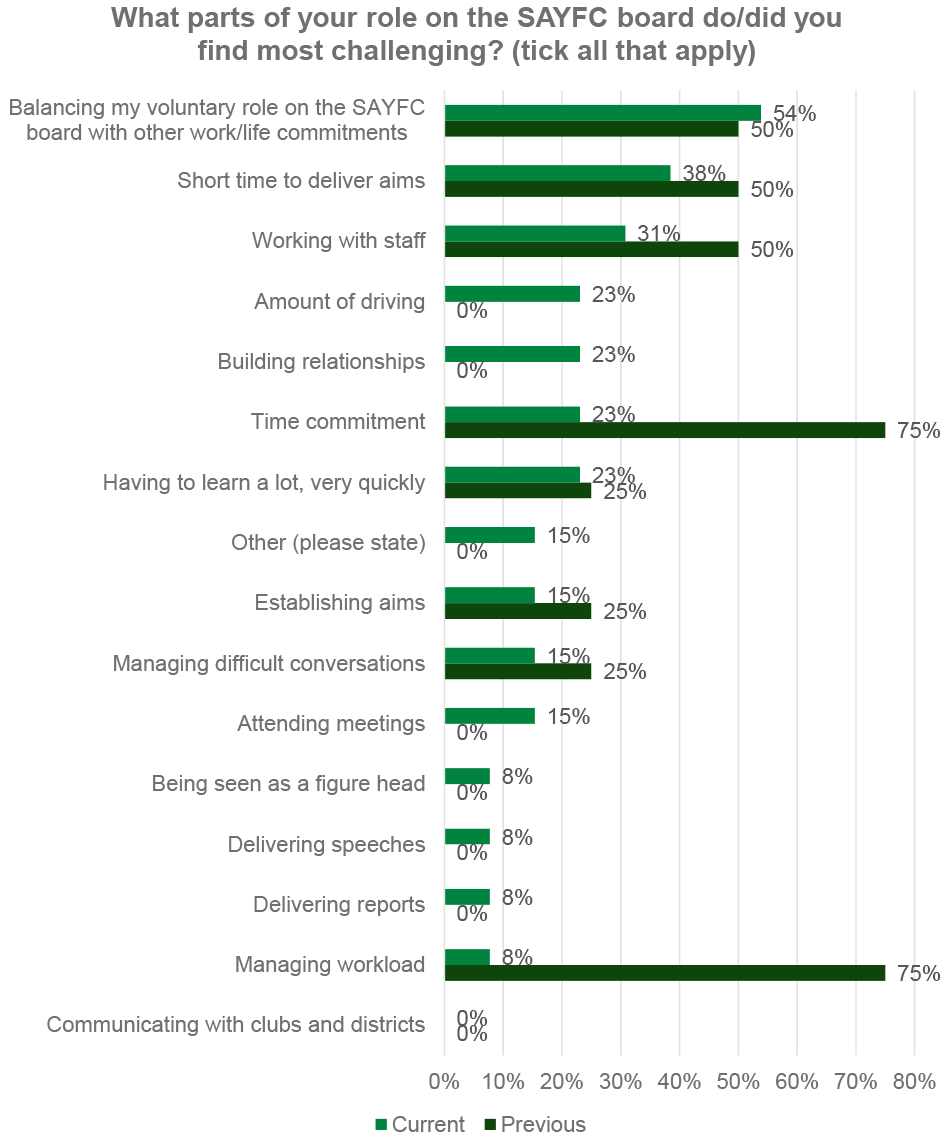
This survey question highlighted the challenges of being on the SAYFC board.
The areas current board members found most challenging were:
- Balancing the voluntary role with other commitments (54%)
- Short time to deliver aims (38%)
- Working with staff (31%)
Current respondents who provided further feedback felt that some challenges lay in the commitment and willingness of other SAYFC board members, and others felt their opinions are not heard.
The areas previous board members found most challenging were:
- Time commitment (75%)
- Managing workload (75%)
- Working with staff (50%)
- Short time to deliver aims (50%)
- Balancing the voluntary role with other commitments (50%)
The areas current board members found less challenging were:
- Being seen as a figure head (8%)
- Managing workload (8%)
- Delivering reports (8%)
- Delivering speeches (8%)
No current board members found communicating with clubs and districts challenging.
No previous board members found these aspects challenging:
- Communicating with clubs and districts
- Being seen as a figure head
- Amount of driving
- Delivering speeches
- Delivering reports
- Building relationships
- Attending meetings
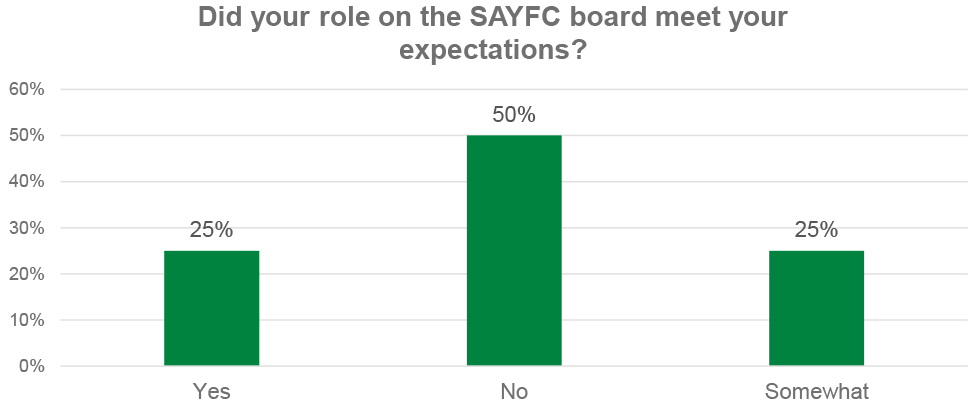
Half (50%) of respondents felt that their role on the SAYFC board did not meet their expectations, while a quarter (25%) felt it did and 25% said ‘somewhat’.
Respondents were asked to explain their responses to this question. Below are some of the reasons they provided:
- Difficult to balance the role with their own career
- Perceived issues in the organisation, including over-reliance on volunteer board members, which can cause tension with paid members of staff, and staff being slow to act or not fulfilling their own role/s (for example, volunteer board members being asked to run entire events)
- Adequate time not given to tasks
- Issues raised are not taken seriously
- Personal relationships can get in the way (favouritism)
- Lack of gratitude for hard work
- A need to rebrand
- A year in the role is not long enough to bring about real change
Some respondents felt that these issues have impacted their own views towards the organisation and their commitment to its aims.
2.6 Further Training and Development
In this section, respondents were asked to provide details on further training or development opportunities they would be interested in, and any further comments.
What further personal development or training opportunities would you be interested in?
Respondents were asked what further training opportunities they would be interested in. Below is a list of topics which respondents would like training in:
- Public speaking – ‘it’s such a big part of the role’
- How to follow and implement strategy
- Chairing meetings – ‘how to make sure everyone feels comfortable and include all in the conversation’
- HR/staff appraisal training – ‘we lack knowledge on how to run this committee in the best possible way’
- Training for specific roles
- Leadership training
- How to manage difficult conversations
- Mentoring
- Knowledge exchange with other organisations
- Personal development skills
- Team effectiveness training – ‘I don’t feel the board are currently working together as much as they could do’
- Bullying, harassment and discrimination
- Social media training
- Handover training
- Career and business-related training
Leadership training, managing difficult conversations and mentoring were the most common training opportunities which respondents stated that they would like to have in the future.
Respondents were asked if they had any further comments about how SAYFC board members can be supported before starting their new role, and suggested:
- More training (including from outside sources)
- More support for new members
- Support for the new board structure
- Leading and chairing meetings
- Training in managing difficult conversations
- How to manage progress
Many of the respondents mentioned mentoring as important in supporting new members, including a better mentoring structure, and more mentoring overall.
Contact
Email: socialresearch@gov.scot
There is a problem
Thanks for your feedback